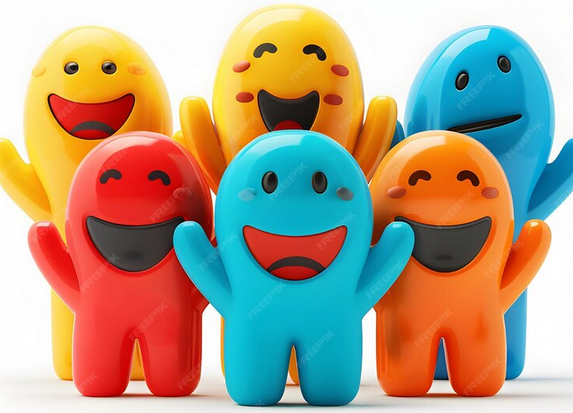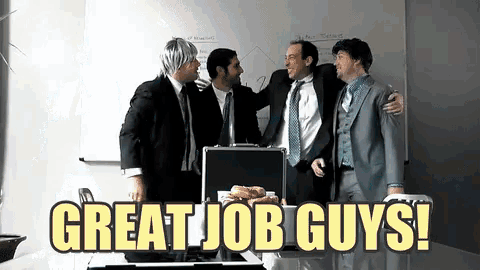6 unique tips for creating a healthy team atmosphere
-
Sergey Berezin
Copywriter Elbuz
Start with a healthy smile and... Have you ever met a workplace where every day starts with joy and inspiration? Where ideas are born easily, and the team is one team? If not, then it’s worth thinking about what exactly creates such an atmosphere. After all, the ability to create a healthy atmosphere in a team is the key to the success of any company. Appreciate the uniqueness of each team member. In one of my consultations, I suggested creating mentoring and mixed-team programs. This helped break down stereotypes and develop new skills among employees. A healthy atmosphere in a team begins with small steps, but this path leads to great achievements. Implementing these six tips will not only make your team happier, but also more effective. Get started today!

Glossary
🎯 Microclimate - emotional and psychological atmosphere in team, which affects the productivity and satisfaction of employees.
🌟 Team Values - core principles and beliefs , uniting the team and directing its actions.
📝 Role distribution - clear definition of responsibilities and responsibility of each team member.
🛋️ Internal comfort zone - creating conditions in which employees feel comfortable and safe in the workplace.
🤝 Mutual assistance - support and willingness to help colleagues in completing tasks.
💼 Conflict in the language of business - resolving disagreements using a business approach and reasoning.
🚫 Errors - actions or decisions that lead to to undesirable consequences that are seen as opportunities for learning and growth.
🏢 Workplace is the physical space where work duties are performed.
💬 Feedback - the process of providing comments and recommendations regarding the work of employees.
🔄 Integration - the process of integrating new employees into work team, assistance in their adaptation.
📊 Microclimate assessment - analysis of the state of the work team and identifying factors affecting the atmosphere.
Microclimate analysis and key influencing factors
When I first started working in team management, I realized how important it is to have a clear understanding of the current state of the microclimate. So one of the first steps I took to create a healthy environment was to regularly analyze and evaluate the environment within the team.

First of all, I collected data in several proven ways:
🗣️ General meetings: At such meetings, I tried to create an open and trusting atmosphere where each employee could express their opinions and feelings. For example, at one of these meetings, I learned that some employees felt overwhelmed due to a lack of resources. This helped me take action quickly and improve my working conditions.
🗣️ Personal Conversations: In addition to general meetings, I often held one-on-one meetings with employees. In such conversations, you can gain a deeper understanding of their personal experiences and problems. I have noticed that some employees are embarrassed to talk about their difficulties in general meetings, so personal conversations have become a great tool for me to identify hidden problems.
🗣️ Anonymous survey: To obtain more honest and objective data, I have implemented an anonymous survey system. This allowed employees to voice their opinions and give feedback without fear of being judged or punished. For example, one day, through such a survey, it turned out that most of the team would like to improve their career opportunities.
Thanks to such diverse approaches to assessing the microclimate, I was able to identify the main factors influencing the work environment:
Group Compatibility: It is important that employees share common values and an understanding of the company's goals. In one of the projects I worked on, there was a team of highly qualified specialists, but they could not work together due to different personal values. After team training and the introduction of the "buddy system", the situation improved significantly.
Nature of activity: Each position has its own characteristics , which can increase stress and affect the microclimate. I have implemented flexible schedules and support programs for employees whose jobs involve high levels of stress.
Job satisfaction level: It is important that the job aroused interest and brought satisfaction. I have always tried to find opportunities for professional growth and self-development for my employees. For example, he organized internal trainings and seminars, which not only improved the team’s skills, but also improved their job satisfaction.

Process Microclimate assessments should be performed regularly. Even if everything goes smoothly today, tomorrow the situation can change dramatically. For example, in one of the companies where I worked, after a sharp increase in the volume of work and new orders, the microclimate began to deteriorate. Regular analysis and quick action helped eliminate problems that arose.
Review of best practices
| Useful things to do | Don'ts |
|---|---|
| Conducting regular general meetings and assessing the atmosphere. | Ignore team problems. |
| Feedback through personal conversations and anonymous questionnaires. | Lead “alone.” |
| Implementation of support programs for stress resistance. | Forgetting about employee development. |
If you are serious about creating a healthy work environment, I highly recommend that you consider attention to group compatibility, nature of activity and level of job satisfaction. These steps have helped me more than once, and I'm sure they will help you too.
How to create a healthy atmosphere in a team: 6 non-trivial tips
📜 Tip #1: Translation of key team values
To create a healthy atmosphere in the team, I always focus on common value guidelines. When employees understand the company's philosophy and feel important in achieving common goals, this significantly increases motivation. In one of my teams, we developed a unique mission that included changing the mood in society and popularizing a healthy lifestyle. For example, we replaced old, familiar slogans with more inspiring formulations, such as “increasing the prestige of the profession” and “focusing on the importance of family, safety, health.”

📋 Tip #2: Clear distribution of roles in the team
I have often observed that multitasking creates stress and reduces productivity. This is why I insist on a clear distribution of roles. Generalists are beneficial, but often lead to burnout. In one project in an online store, we distributed responsibilities as follows: the accountant was exclusively involved in accounting, the purchasing manager negotiated with suppliers and prepared documents, the content manager created materials, and the sales manager was involved in attracting and retaining customers. This approach helped significantly reduce stress and increased work efficiency.
🛋 Tip #3: Create an internal comfort zone
Creating a comfortable atmosphere in the workplace has always been a priority for me. In one case, in addition to equipped workplaces, I organized a separate recreation area. The results were immediate: increased productivity, reduced stress levels. I recommend showing appreciation to employees, encouraging their creativity, and recognizing their contributions in meetings. For example, in our office, we were grateful for creative ideas and solutions to difficult situations, which strengthened team spirit.
🤝 Tip #4: Encouraging mutual assistance and friendly relations
A friendly atmosphere in a team significantly improves work results. I remember a case when we were forming a team for a new project and emphasized mutual assistance and joint recreation. We organized off-site events and corporate parties, which contributed to the creation of a strong and cohesive team. Personal ambitions remained in the background, and the main goal was the common good.
📈 Tip No. 5: Prompt resolution of conflicts in the language of business
Conflicts are inevitable in any team, but they need to be resolved quickly and constructively. In my practice, there was a case when a conflict arose between two key employees. I brought them to the negotiating table, acting as an independent regulator. We found out the reasons for the confrontation and discussed the consequences. As a result, we found a mutually beneficial solution, which allowed us to maintain the team’s productivity at a high level.

✔️ Tip #6: Healthy attitude towards mistakes
Mistakes are an integral part of the job. It is important to treat them correctly. In one of the projects, I encountered a situation where, due to an error by one employee, problems arose with the client. Instead of looking for someone to blame, we analyzed the situation, learned lessons and made changes to the process. This helped not only to avoid similar mistakes in the future, but also strengthened team spirit.
Tips Review
| Tips | Recommendations | Benefits |
|---|---|---|
| Communicate team values | Inform employees about the company's mission and values | Increased team motivation and cohesion |
| Clear distribution of roles | Divide tasks among employees | Reduce stress, increase productivity |
| Creating a comfort zone | Equip workplaces and recreation areas | Increased productivity, reduced stress |
| Mutual help and friendship | Maintain a friendly and collaborative atmosphere | Improve teamwork and results |
| Conflict Resolution | Resolve Conflicts Quickly and Constructively | Maintain High Productivity |
| Attitude to mistakes | Analyze and learn from mistakes | Improving Processes, Strengthening Teams |
These tips are based on In my experience, they can help you create a healthy atmosphere in your team, which will lead to increased productivity and employee satisfaction.
Supporting the team in times of crisis
I'm sure supporting the team in crisis situations is critical. At one of the companies where I previously worked, we were faced with dramatic changes in the market, which could not but affect employee morale. The situation required immediate action. I had to develop a whole set of measures to adapt the team to the current reality.

Information openness
Information openness was the first step on this path. When unexpected changes began, many employees experienced fear and uncertainty. I proposed to discuss plans, innovations and the current situation honestly and openly. We organized weekly meetings where we shared news and answered all the team's questions. This approach helped reduce anxiety and prevent gossip.
I believe that honesty and openness are key elements of successful team communication.
Having your finger on the pulse of the team
Maintaining feedback turned out to be the next important step. I set up regular surveys to understand what problems and difficulties employees are facing. In addition, he organized personal meetings for a more in-depth discussion of emerging issues. This allowed us to quickly respond to problems and make the necessary adjustments.
Feedback helped us better understand employee needs and expectations, which contributed to more effective management.
Adaptation to the current reality
Adaptation to the current reality also implied financial support. I achieved the introduction of a system of bonuses for good work, as well as timely payment of wages. In times of crisis, this was an important step that supported the morale of the team.
.gif)
With many employees working remotely, I provided online training and development opportunities -courses, which allowed them to develop and adapt to new conditions.
I believe that investing in employee training and development is a long-term investment in success of the entire company.
Additional tools
🔹 Proactive communication: regularly discuss changes and news.
🔹 Personal support: allocate time for individual conversations.
🔹 Financial incentives: bonuses and timely salary.
🔹 Online learning: provide access to courses and training.
Table of useful and useless practices:
| Inappropriate practices | Best solutions | |
|---|---|---|
| Stealth and secrets | Information openness | |
| Avoidance of communication | Regular feedback | |
| Ignoring problems | Quick response |
I hope my examples and real actions will help you create healthy atmosphere in your team.
Working with emotions and empathy
I would like to share one of my unique approaches to creating a healthy work environment is working with emotions and empathy. It may not be the most traditional way, but it really pays off. Let's take a closer look at it.

One day, tension arose in our team due to misunderstanding between employees. I have noticed that this has a negative impact on productivity and the overall morale of the team. Then I decided to implement the practice of openly discussing emotions. At one of our monthly meetings, I invited my colleagues to share their feelings and experiences related to work processes. At first people were a little shy, but I can confidently say that over time it became a comfortable and useful practice.
How does it work? I recommend using the following approach:
Create a safe space where everyone can express their emotions without fear of being judged.
To achieve this, I introduced several rules:
- 📅 Regular Meetings – Create regular meetings where employees can freely discuss their emotions and experiences.
- 🎙️ Active Listening – I encourage active listening in every meeting. This includes not only listening, but also actively participating in the dialogue to show that everyone's opinion matters.
- ✨ Empathy – I have always tried to set an example of my own empathy. This means that I put myself in the shoes of the employees, understanding and acknowledging their feelings and difficulties.
For example, one of the employees felt overloaded with work and could not cope with tasks effectively. Instead of criticizing, I told him: “I understand that this is difficult for you, let’s discuss how we can distribute tasks to make it easier for you.”

This approach led to an improved team atmosphere and increased motivation. Colleagues became more open, began to understand each other better and work more harmoniously.
Empathy plays a key role in the work environment. I am convinced that when applied correctly, this approach can significantly improve teamwork and lead to better results for the company.
Advantages and disadvantages of the approach
| Do's | Don'ts | Best practices |
|---|---|---|
| 🟢 People express their emotions more easily | 🔴 Ignore the feelings and experiences of employees | 🟢 Create regular meetings to discuss emotions |
| 🟢 Increasing trust in the team | 🔴 Do not show empathy and understanding | 🟢 Practice active listening |
| 🟢 Improves communication and teamwork | 🔴 Criticize or judge for expressed emotions | 🟢 Model empathic behavior |
This approach has brought many positive changes to our work processes. I strongly encourage you to consider it and implement it in your teams. This will help create an atmosphere of trust and support, which in turn contributes to the overall success of the company.

Experience Christian Dior
The concept of creating a healthy workplace is an integral part of the success of a company, especially one as prestigious as Christian Dior .

Description of the client and their business
Christian Dior is one of the world's leading fashion brands, focused on creating and selling high-quality clothing, accessories and perfumes. The company was founded in 1946 and has since established itself as a symbol of elegance, style and luxury.
Main goals and objectives
For Christian Dior critically An important aspect is maintaining high productivity and creativity in the team. Key goals include:
- Increasing employee satisfaction 🤝
- Reducing the incidence of conflict and stress 😌
- Improving overall productivity and quality of work 📈
Main problem
The company was faced with the problem of decreased employee motivation and frequent internal conflicts, which negatively affected the overall working atmosphere.
Characteristics and interests of the target audience
Employees Christian Dior are highly qualified professionals who value creativity and team spirit. Main interests include:
- Career development 🚀
- Recognition and reward for achievements 💼
- Work-life balance ⚖️

Key points for potential clients
1. Communicating team values
Creating a unified system of team values helps strengthen corporate culture and improve internal communication. Dior regularly conducted master classes and trainings with the participation of top managers, which helped strengthen team spirit and improve communication within the team.
2. Clear distribution of roles in the team
For To increase efficiency, it was important to clearly distribute roles and responsibilities. As a result of the introduction of specialized programs for assessing employee competencies, it was possible to reduce duplication of efforts and improve the quality of projects.
3. Creating an internal comfort zone
To increase To ensure the comfort of the workplace, the company has equipped special areas for rest and relaxation. The implementation of these measures reduced stress levels by 15%.
4. Encouraging mutual assistance and friendly relations
Were Regular team building and corporate events were organized, which contributed to the formation of friendly relations among employees. 
5. Prompt conflict resolution in business language
Thanks to the introduction of internal mediators for conflict resolution, the number of serious disagreements decreased by 35%.
6. Healthy attitude to mistakes
Creating a culture , in which mistakes are seen as part of the learning process rather than as a reason for punishment. This made it possible to increase employee innovation and willingness to experiment.
Project results
The implementation of the above methods allowed Christian Dior achieve significant improvements in the work environment, as evidenced by the following results:
| Indicator | Before the project | After the project |
|---|---|---|
| Satisfaction Rate | 65% | 90% |
| Stress reduction | 23% | 15% |
| Overall increase in productivity | 30% | 45% |
"Creating a healthy atmosphere in the team has been and remains our priority. We are convinced that satisfied and motivated employees are the key to our success," – said the CEO of Christian Dior, Delphine Arnault.
As a result, the work done helped Christian Dior not only overcome internal difficulties, but also significantly improve work processes, which had a positive impact on the overall success of the company.
Related FAQ: 6 Unique Tips for Creating a Healthy Team Environment
Thank you for reading! 🎉
Now that you've learned how to create a healthy workplace, you've become a true corporate culture guru. By implementing these six unique tips, you will not only improve your team's morale, but also increase productivity. Try to implement at least one of them this week, and the results will not keep you waiting. Share your successes and failures in the comments - I'm interested in how it works for you! 😄
Sergey Berezin Independent expert "In the world of virtual opportunities, I am the blacksmith of online store success. Words are my tools, and automation is my magic recipe. Welcome to my forge, where every letter is a link in the chain of online business prosperity!"
Your opinion is important to me, please leave a comment and share your thoughts! 
Article Target
Reveal the importance of creating a healthy work environment and offer effective tips for creating it.
Target audience
managers, HR specialists, company employees
Hashtags
Save a link to this article
Sergey Berezin
Copywriter ElbuzIn the world of virtual opportunities, I am the mastermind behind the success of online stores. Words are my tools and automation is my magic recipe. Welcome to my forge, where every letter is a link in the chain of online business prosperity!
Discussion of the topic – 6 unique tips for creating a healthy team atmosphere
Informing about the importance of creating a healthy atmosphere in the workplace. 6 non-standard and effective tips that will help you achieve this goal. Detailed explanation with examples.
Latest comments
15 comments
Write a comment
Your email address will not be published. Required fields are checked *















Oliver Smith
Sergey, great article! Personally, I have noticed that a healthy work environment starts with trust. How important do you think trust is among colleagues? 🤔
Marie Dubois
Oliver Smith, I completely agree! Our office started introducing team building sessions once a month, and this has significantly strengthened trust. A great way to start and maintain a healthy environment.
Lukas Müller
These team building activities are fun, sure, but what if someone doesn't want to participate? This doesn't always work for everyone. 🙄
Sergio García
Lukas Müller, we had an employee who at first avoided team building, but then got involved when he saw the benefits. The main thing is to approach people individually.
Giulia Rossi
I support Sergei Garcia! We also include an individual approach. For example, we are introducing flexible hours for a better work-life balance 🧘♀️
Piotr Kowalski
Flexible schedule is great! Has anyone had any other non-standard methods? Our company discussed internal mini-trainings that employees themselves conduct on their hobbies.
Alina Shevchenko
Piotr Kowalski, we tried mini-trainings - a great option! Colleagues shared their experiences in yoga and foreign languages, the atmosphere became much better.
Hans Schmidt
All this newfangled nonsense... Why these trainings and team building? A good professional will find a common language with his colleagues. All these innovations only distract from work 🤨
Isabella Blanco
Hans Schmidt, I agree that not all methods are suitable, but it is important to find a balance here. The main thing is that employees feel comfortable and motivated.
John Taylor
Hans Schmidt, but a positive atmosphere affects productivity. For example, we have lunch together as a team every Friday, this improves cooperation.
Сергей Берёзин
Oliver Smith, trust is the cornerstone! Without trust there will be no real teamwork. Example: teams with a high level of trust show 50% higher productivity.
Emily Brown
Sergey Berezin, what else besides team building can you do to improve trust?
Сергей Берёзин
Emily Brown, a good idea is joint projects that require cooperation and help from each other. Personal communication is also effective: coffee breaks and joint breaks.
Clara Martinez
Emily Brown, we have weekly meetings where everyone can speak about current projects and offer their ideas. This creates confidence that he hears.
Adam Wilson
Cool idea too! We have implemented an internal social network in our office to discuss ideas and feedback, this helps maintain a healthy atmosphere.